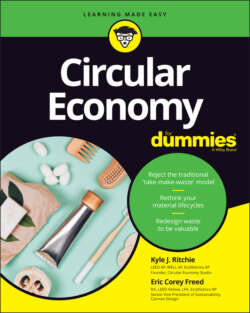Читать книгу Circular Economy For Dummies - Eric Corey Freed - Страница 101
Durability and reparability policies
ОглавлениеImproved durability and the incorporation of policies that empower the product owner to repair the products they own are two key principles missing from the modern economy. A product’s ability to be durable, reusable, repairable, upgradeable, and “remanufacturable,” for lack of a better term, begins at the design phase. This is where the greatest potential for material and cost savings can be embedded into the design of the product itself. By incorporating circular methods into the design of the product, manufacturers can greatly reduce the cost of raw materials required while also benefiting the end user by eliminating replacement costs. Although replacement costs may be substituted with repair costs, the cost of maintaining a product is much more affordable than buying a new product every time a single element fails. But what does durable really mean in this context? How do you define what’s durable? Because durability is relative to the product itself, its rate of use, and thousands of other variables, determining what makes a product durable is nearly impossible. You can see how this makes the development of durability policies difficult to produce and enforce.
Aside from that difficulty, one key strategy is associated with durability: repairability. The innate ability of a product to be maintained, repaired, customized, reused, and upgraded inherently makes it durable. Therefore, addressing durability will always require addressing repairability as well. But what’s the value of buying a repairable product if fixing it is nearly impossible? That’s a great question, my friend. On top of ensuring that the product has been designed to be repaired (and is therefore durable), manufacturers must make sure that spare parts, and the tools necessary to swap out those parts, are easy to acquire (both physically and financially). They must also ensure that the information or step-by-step guide required to make the repair correctly is readily available.
Although these two enabling conditions for repairability are critical, many manufacturers intentionally try to limit the number of sources who have access to the variety of parts and pieces required to properly repair their products. Building this customer dependability into products ensures that the range of competition is limited from the start and that the additional revenue associated with repair and replacement is directed back to the business rather than to its competitors. This is why, historically, the screws used in the Apple iPhone require a specialty drill bit to remove — not one typically sold in stores. Other strategies for limiting the repairability of products is to make the spare parts in older models incompatible with new models so that customers are required to purchase tertiary items to support their purchase of the primary product.
To fight against this built-in, planned obsolescence, standards will be required in order to accommodate minimum requirements for product variables such as lifespan, repairability, and recyclability at the end of its useful life — assuming that there is an end of life. There are few examples where these standards now exist, because it’s difficult to determine the anticipated performance of products while accounting for user error, rate and duration of use, and so on.
Although it will be difficult to create innovative policies that affect the repairability, durability, and recyclability of products of the future, two approaches look promising: legal requirements and customer education. By developing legal requirements that make products more repairable, durable, and recyclable, products will need to be designed correctly at the start of the lifecycle process — rather than be adapted later. Other legal requirements may include making spare parts available for a certain number of years after production. As mentioned earlier, repairability of a product is irrelevant if the proper information on how to repair products properly is unavailable. Manufacturers should be required to provide adequate information to not only their customers but also repair companies that want to repair an array of popular products. Assuming that it costs less to repair a product than to purchase it new, implementing these legal requirements and education materials are the key to increasing the repairability, durability, and recyclability of products within a circular economy.
